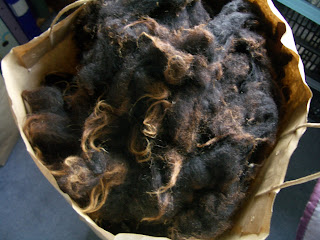This project started back on 27 June, when Guild members were demonstrating spinning at the RSPB place at Saltholme - they have a small flock of Shetland sheep keeping the grass short, and it was shearing day.
I returned from there with a black Shetland fleece, a black Hebridean fleece, and half a grey Shetland fleece. (To add to the 2 Shetland fleeces bought from Woolfest.) My fibre preparation skills have had a good deal of practice since then!
The grey Shetland and the black Hebridean produced some tough yarn, so weaving seemed best.The warps were arranged in groups, black at the edges, then 4 grey alternating with 4 black, then a middle section of 2 grey alternating with 2 black. 3 separate sections were woven, the first one with black and grey wefts in varying groups; one with an inch of black weft alternating with 3 inches of weft in a multi-colour wool/linen yarn; and the 3rd section with a weft consisting of one strand of black together with one strand of grey.
The first 2 sections have now been made up into bags -

The straps are the same yarns woven on the inkle loom, in a tweedy stripe for the black and grey bag, and in an interwoven pattern for the multi-coloured one - this inkle has a narrow stripe of the multi-coloured wool/linen yarn between the border and the central pattern.
Both bags are lined with home-dyed cotton fabric from the quilting stash - purple for the black and grey bag, and green for the multi-colour one. Hand-stitched.
The button box yielded a suitable large button for a closure for the black and grey bag, but a search of the Durham shops had to be undertaken for the black horn bead that forms the closure on the multi-colour one.
They will have an outing to Gateshead next month, as part of a Guild exhibition.








